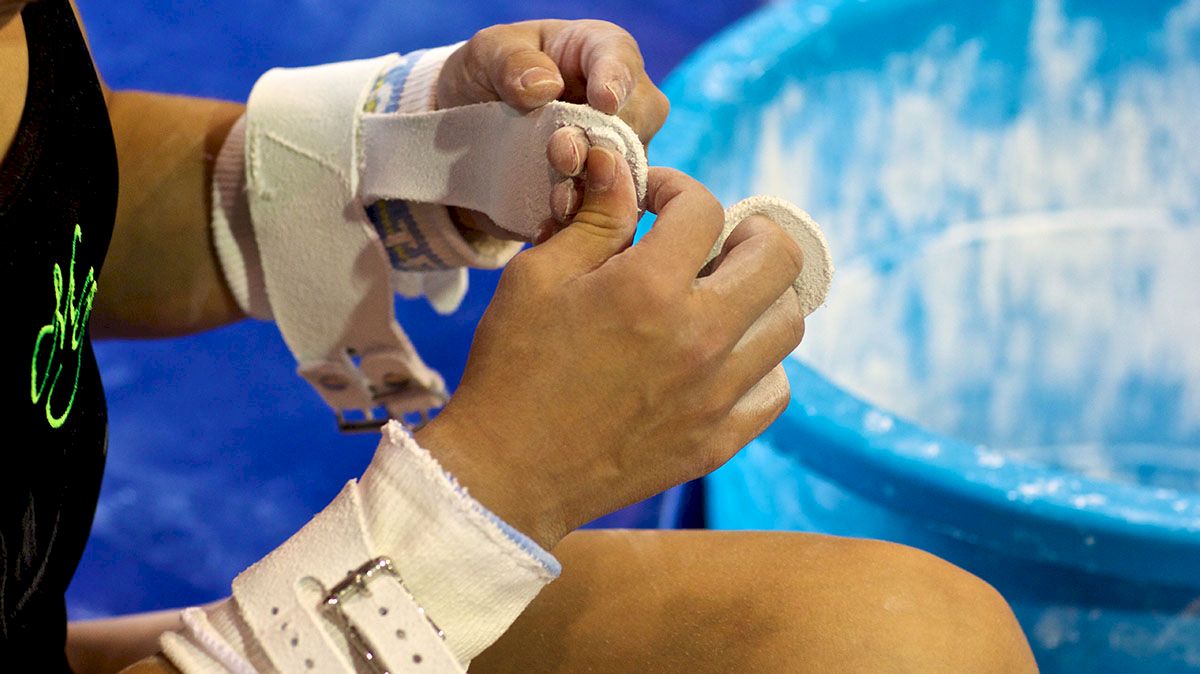Crafting a Bars Routine: An Analysis of the D-Score
Crafting a Bars Routine: An Analysis of the D-Score
Crafting a Bars Routine: An Analysis of the D-Score


In the third part of our series on D-score analysis, we’re taking a look at uneven bars, historically one of the tougher events for American gymnasts to compete on the world stage. While floor exercise and balance beam had similar requirements in the makeup of the D-score, uneven bars is a whole different story. Indeed, routines on uneven bars happen so quickly that it can be tough as a spectator to catch each individual move. Below you’ll find a guide to calculating the D-score on uneven bars, including an illustration using Kyla Ross’s routine from 2013.
The “Must Haves”
There are five core ingredients to an elite bars routine that must be included to receive the full 2.5 points for Composition Requirements (CR). As with beam and floor, every elite gymnast should receive the full 2.5 points easily unless they make a major error. On bars, a flight element from the high bar to the low bar is required (example: a Pak Salto); a flight element on the same bar is required (example: a Tkatchev); different grips throughout the routine is required; a non-flight element with a minimum full turn is required; and, finally, a dismount (D-level or higher for full credit, such as a double layout).
The Magic Number 8
As with beam and floor, the D-score on bars is calculated by combining the values of the top highest difficulty 8 elements, including the dismount. Judges like to see a variety of circle and swings and flight elements. Giant circles forward and backward, swings and clear hip circles, stalders forward and backward, pike circles forward and backward, counter flights, vaults, hechts, and saltos are the typical moves which you’ll tend to see at the elite level.
Connecting is Crucial
Uneven bars is an entirely fluid event, and the more moves a gymnast can connect, the better. Gymnasts will be awarded either a +0.10 or a +0.20 bonus to the D-score for connecting various elements. Connecting two D-skill elements (or more) would result in a +0.10. Connecting a D flight element to a C element (in that order), or more, on the high bar results in +0.20, as will connecting D and E flight elements.
Because bars is an event where the gymnast is constantly moving, it can be a bit confusing to recognize where Connection Value (CV) is counted and where it isn’t. In the Code of Points, it states that if an “empty swing” or “intermediate swing” is performed between two elements, CV is not awarded. An “empty swing” is defined as a swing forward/backward without the execution of an element, before the swing reverses to the opposite direction. There are a few exceptions to this rule, such as a Shaposhnikova type skill. An “intermediate swing” is defined as a pump swing from front support and/or a long swing not needed in order to perform the next element.

Putting It All Together - The Final D-Score
To put all of these rules into a real-life example, let’s take a look at Kyla Ross’s bar routine from 2013 Worlds, before she downgraded due to injuries. She started with a Komova II (E) connected into a Pak Salto (D). She then performed a Van Leeuwen (E). Next, she performed an Inbar Stalder with half turn (D) connected into a Jaeger (D). She performed an Inbar Stalder with a full turn (E), connected into an overshoot to handstand (D). And she finished with a double layout dismount (D).
As noted, only the highest 8 elements count for difficulty value. Kyla’s bar routines have always been super efficient and actually only contain 8 elements anyway. Those elements in 2013 were: Komova II (E) + Van Leeuwen (E) + Inbar Stalder with Full Turn (E) + Pak Salto (D) + Jaeger (D) + Overshoot to Handstand (D) + Inbar Stalder with Half Turn (D) + Double Layout Dismount (D).
Her total point value was therefore 3.5.
Kyla also satisfied all of the Composition Requirements. Her Pak Salto counted for her flight element from the high bar to the low bar (as did her overshoot), her Jaeger was her flight element on the same bar, she performed different grips throughout the routine, she performed a full turn, and finally, a D-level dismount. She therefore received the full 2.5 points.
Lastly, Connection Value. Kyla’s Komova II connected into a Pak Salto counted for +0.20. Her Inbar Stalder with Half Turn connected into a Jaeger counted for +0.10. Lastly, her Inbar Stalder with Full Turn connected into an overshoot to handstand counted for another +0.10. Total connection value was therefore 0.40.
Adding it all together, you have 3.5 points for her top 8 skills, 2.5 points for Composition Requirements, and 0.40 for Connection Value. Totaling it up, Kyla received a 6.4 D-score. In 2014, Kyla had to downgrade her routine by replacing her Stalders with Toe-On Circles, lowering her top 8 elements and her connection value, resulting in a 5.9 D-score at 2014 Worlds.
Stay tuned for the final part in the series on D-score analysis, where we'll look at how the difficulty level on vault has evolved over the years!
Related:
Crafting a Beam Routine: An Analysis of the D-Score
Crafting a Floor Routine: An Analysis of the D-Score